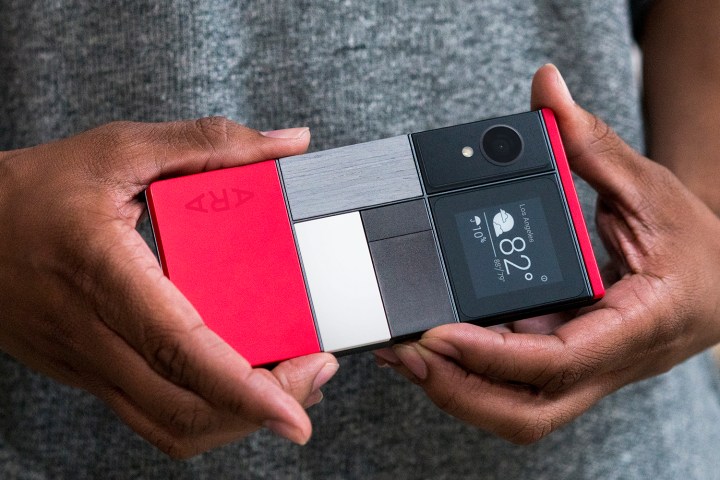
Although these upcoming products are hogging the spotlight, some of the more interesting projects Google is working on are shrouded in secrecy. Its hardware division — ATAP, or Advanced Technology and Projects, is known for its moonshots, the crazy projects that take impossible ideas and make them possible.
At Google I/O, ATAP quietly gave some updates on its most popular moonshots: Project Jacquard, an attempt at smart clothes; Project Soli, a move towards gesture tech; and Project Ara, a truly modular
Google is also working on a handful of lesser known projects like coding games for kids, autonomous Android-powered vehicles, and robots with creative impulses. Here are 6 of the coolest projects Google has cooking.
Project Jacquard
There are times when you simply should not be holding your
Jacquard was announced in 2015, but at I/O this year, Google gave us a demo of the first prototype in collaboration with Levi’s. The Commuter jacket is able to add pins to the wearer’s map, play the next song, and more — all with just a swipe or tap of the sleeve. Google says the Commuter jacket from Levi’s will be available in the spring of 2017, but it’s opening up the platform for developers to add support for their apps later this year. Soon, any clothing company will be able to weave its garments with gesture-sensing fabric, and the best part? You can machine wash your techie clothes.
You can learn more here:
Project Soli
Project Soli also revolves around the idea of hands-free control — but it extends to almost any device that can integrate a Soli chip. This is another project Google unveiled last year, but has since improved considerably. At I/O 2016, Google showed that it has miniaturized the chip, so it can now fit in something as small as a smartwatch. Soli uses radar technology that allows people to control objects via hand gestures. For example, if your speakers have an embedded Soli chip, you could theoretically change the song with a wave of a hand from across the room. In person, it’s really amazing to see gesture control without any cameras or sensors visible.
The chip’s range extends to 15 meters, but it can also be utilized when you’re really close — a Google ATAP representative controlled a Soli-embedded smartwatch via a hand gesture at the I/O event. The Soli development kit will launch next year.
You can learn more here:
Project Ara
Project Ara may be the most anticipated ATAP project from Google. If you ever found yourself longing for the latest tech in smartphones, but couldn’t afford to buy a new device — Ara may be the right answer. Google believes you shouldn’t need to upgrade your whole device just to get a better camera. Instead, why not buy the newest camera module and replace the old one from your phone? Ara makes modular phones a reality. Google is making modules — like high-quality cameras, a bigger capacity battery, secondary E-Ink displays, and high-definition speakers — that you can simply swap out of your Ara device. Unfortunately, this doesn’t apply to the processor and
The coolest demonstration at I/O 2016 was when Google’s Engineering Lead Rafa Camargo said, “OK Google, eject my camera,” and the camera module popped out from the phone. The Project Ara development kit will be available later this year, and Google says the first Google Ara device will launch in 2017.
You can read more here:
A robot painting a cube

Google is home to a number of interesting projects, including a robot arm that was painting a cube. At Google I/O 2016 a robot held a paintbrush and spattered a large white cube with colorful drops of paint a la Jackson Pollock. However, the spray wasn’t totally random — the robot’s actions were directed by a person using an app on a
This isn’t a consumer device that you’ll be able to buy, but it is an interesting demonstration of the power of robots and the ability to control robots with a
MIT and Google bring coding to kids

MIT and Google introduced the next-generation of the kid-friendly visual coding language “Scratch” at I/O. The open source version of the language is called “Scratch Blocks,” and it’s based on Google’s visual programming code Blockly. The idea is to teach young kids the basics of code with visual blocks that you snap together either horizontally or vertically. The new version is better suited to mobile devices like tablets and smartphones, and the developer preview is available now. We saw the coding language in action on a Lego set, and moved a block to get the Lego set’s arm to spin a third time.
Google and MIT hope to bring coding apps and kits to kids in the future, though it’s just research for now.
You can read more here:
Autonomous Android Vehicle
Every year, Google challenges its fans to create interesting Android experiments, and this year’s winner was the Autonomous
We saw the vehicle in action, as it chased a bright green ball on a string. Every time an obstacle presented itself, the vehicle smartly moved out of the way and found a new route. Although you can’t buy this Android-powered robot at the moment, it’s proof that
You can read more here:
Editors' Recommendations
- This is the one AI feature from Google I/O 2024 I can’t wait to use
- I saw Google’s futuristic Project Astra, and it was jaw-dropping
- Google has a magical new way for you to control your Android phone
- Google just announced 10 huge updates for your Android phone
- The 4 biggest things Google didn’t announce at Google I/O 2024


